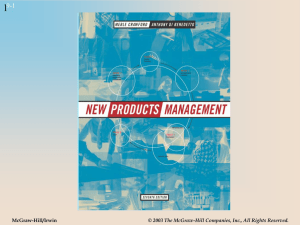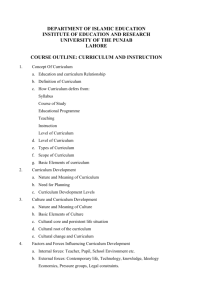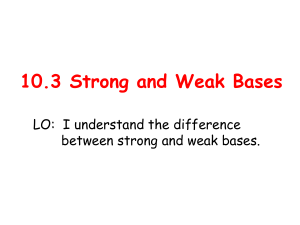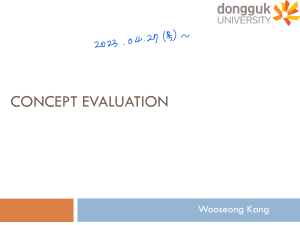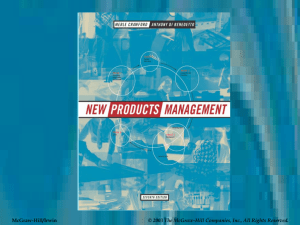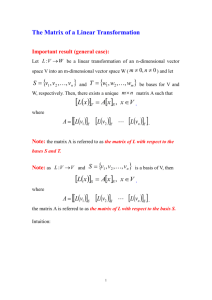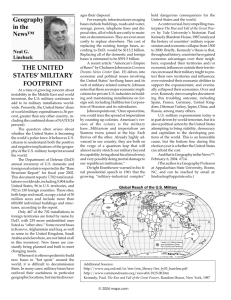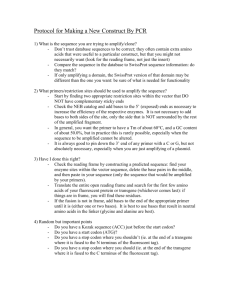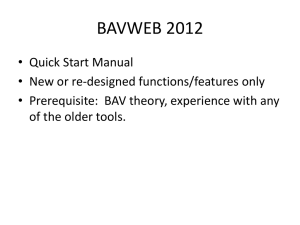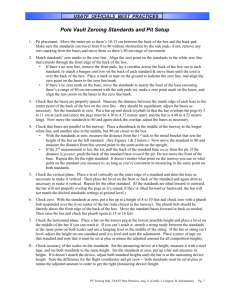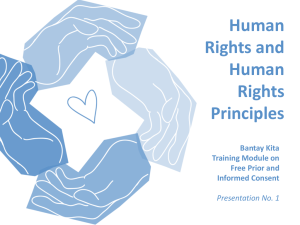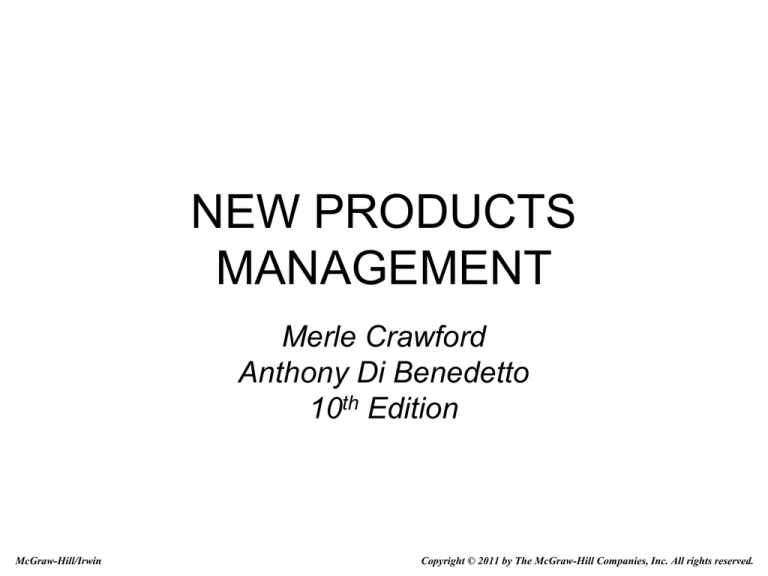
NEW PRODUCTS
MANAGEMENT
Merle Crawford
Anthony Di Benedetto
10th Edition
McGraw-Hill/Irwin
Copyright © 2011 by The McGraw-Hill Companies, Inc. All rights reserved.
Chapter 09
Concept Testing
9-2
Many Ideas Are Eliminated
Before Concept Testing
• PIC eliminates most new product ideas even before they
are developed into concepts.
• Ideas of the following types are excluded:
– Ideas requiring technologies the firm does not have.
– Ideas to be sold to customers about whom the firm
has no close knowledge.
– Ideas that offer too much (or too little) innovativeness.
– Ideas wrong on other dimensions: not low cost, too
close to certain competitors, etc.
9-3
Market Analysis and Initial Reaction
• Market analysis: in-depth study of market area that the
PIC has selected for focus.
– Conducted immediately after PIC approval.
• Initial reaction: preliminary, inexpensive assessment of
concepts, which may be flowing very quickly at this point.
– Avoid “bazooka effect” (quickly blasting out concepts
without forethought)
– Do not include idea source in initial reaction.
– Respect the “fragility of ideas” — have more than a
single person involved.
– Use more than pure intuition — keep records and stay
objective.
9-4
Suggested Questions for the
Initial Reaction
• Market Worth: what is the attractiveness of the
new product to the targeted customer
population?
• Firm Worth: Is the new product project viewed
positively by management? Does this new
product project enhance the firm’s
competencies?
• Competitive Insulation: Can the product’s
advantage be maintained against competitive
retaliation?
9-5
Concept Testing Cautions and
Concerns
• If the prime benefit is a personal sense (aroma,
taste).
• If the concept involves new art and entertainment.
• If the concept embodies a new technology that
users cannot visualize.
• If concept testing is mishandled by management,
then blamed for product failure.
• If customers simply do not know what problems
they have.
– Consider: how useful would be the concept test results
for the Ferris wheel? The first microwave? Diet fast
9-6
food burgers?
What Is a Product Concept
Statement?
• A statement about anticipated product features
(form or technology) that will yield selected
benefits relative to other products or problem
solutions already available.
• Example: “A new electric razor whose screen is
so thin it can cut closer than any other electric
razor on the market.”
• Recall the importance of getting responses to
product concepts and not simply ideas (Chapter
4).
9-7
Purposes of Concept Testing
• To identify very poor concepts so that
they can be eliminated.
• To estimate (at least crudely) the sales
or trial rate the product would enjoy
(buying intentions, early projection of
market share).
• To help develop the idea (e.g. make
tradeoffs among attributes).
9-8
Procedure for a Concept Test
•
•
•
•
•
•
•
•
•
•
Prepare concept statement
Clarify specific purposes
Decide format(s)
Select commercialization
Determine price(s)
Select respondent type(s)
Select response situation
Define the interview
Conduct trial interviews
Interview, tabulate, analyze
9-9
Some Key Issues in Concept
Testing
•
•
•
•
Concept statement: narrative, drawing, model?
Respondent group: Lead users? Large users?
Response situation: Where? How?
Interviewing sequence: Is the concept understandable?
Believable? Important? Interesting? Realistic? Would it
work? What problems do they see? Would they buy?
• Test procedure, change and implement, study findings.
9-10
Mail Concept Test — Verbal Description
Here is a tasty, sparkling beverage that quenches thirst, refreshes, and
makes the mouth tingle with a delightful flavor blend of orange, mint, and
lime.
It helps adults (and kids too) control weight by reducing the craving for sweets
and between-meal snacks. And, best of all, it contains absolutely no
calories.
Comes in 12-ounce cans or bottles and costs 60 cents each.
1. How different, if at all, do you think this diet soft drink would be from
other available products now on the market that might be compared
with it?
Very different ( ) ( ) ( ) ( ) Not at all different
2. Assuming you tried the product described above and liked it, about
how often do you think you would buy it?
More than once a week ( ) ( ) ( ) ( ) ( ) ( ) Would never buy it
9-11
Mail Concept Test — Sketch
9-12
Benefit Segmentation in Swimsuit
Market
x xxx x
x
x x
x
x x x x
x
Segment 2
x
x xx x
x x
x
x
x xx x x
Segment 3
x
x xx x
x
Segment 1
x x
x
x x x x
x
Fashion
x
9-13
Aqualine
Islands
Comfort
Joint Space Map Showing Ideal
Points
3
2
1
Molokai
Fashion
Splash
Sunflare
9-14
Joint Space Map Showing Ideal
Vectors
Aqualine
X
Islands
Molokai
Fashion
Sunflare
Splash
9-15
Conjoint Analysis in Concept
Testing: EZPass
• Key attributes: number of accounts to
open, how to apply and pay for an
account, number of EZPass lanes at each
toll plaza, etc.
• 11-minute video of product in action and
its effectiveness in reducing congestion.
• Respondents all received the video, a
questionnaire, and scenario cards showing
combinations of attributes.
9-16
Market Research to Support
Concept Testing: BASES
• 300 adult female respondents surveyed.
• Nestle Refrigerated Foods example (Contadina Pasta)
• 75% top-two-boxes score (24% definitely + 51%
probably would buy).
• Median top-two-boxes score for this category: 61%.
• Split respondents into favorable (the 75% in the top two
boxes) and unfavorable.
• Both groups liked the same things: product is natural,
offers variety, is fresh, saves time, is easy to prepare.
• Most common negative: price.
9-17
BASES (continued)
• BASES tried three positioning statements:
Homemade, Pasta Dinner, and Superior;
Superior was found to have more likes and
fewer dislikes and was selected.
• Obtain adjusted trial through rough rule of
thumb: 80% of the “definitely” + 30% of the
“probably” will actually buy, or:
(0.8 x 24%) + (0.3 x 51%) = 34.5%
• Assuming 48% awareness and 70% availability,
we get :
AW x T x AV = 0.48 x 34.5% x 0.70 = 11.6%
9-18
BASES (continued)
• Total number of trial households:
target households x trial rate =
77.4 million x 11.6% = 9 million.
• To get an estimate of Repeat, use:
Repeat for similar products = 39%
Average customer repeat = 2.5 times
No. of units bought per purchase occasion = 1.4
Repeat estimate = 39% x 2.5 x 1.4 = 136.5%
(Note: this repeat calculation is slightly different
than in the text, but is used at BASES.)
9-19
BASES (continued)
• Therefore the final prediction of sales
based on A-T-A-R is:
9 million x 136.5% = 12.3 million.
• According to Nestle, the greatest
uncertainty was in the Repeat estimate of
39%, so a worst case scenario was tried.
Even at a worst-case 27% repeat rate, sales
forecast was still 8.5 million which still
surpassed Nestle objectives.
9-20

